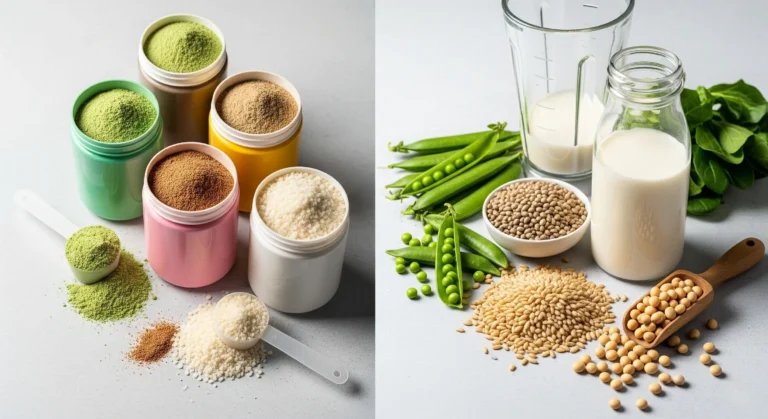
Picture this: you’re standing in the supplement aisle, staring at dozens of protein powders, completely overwhelmed by the choices. Whey? Casein? What’s the difference, and does it really matter which one you choose? I’ve been there too! After years of trial and error (and honestly, wasting money on the wrong supplements), I’ve learned that timing and protein type can make a huge difference in your results. Did you know that these two milk-derived proteins are absorbed by your body at dramatically different rates? This one factor alone could be the difference between optimal recovery and wasted potential! In this article, I’ll break down everything you need to know about whey versus casein protein, helping you make the right choice for YOUR specific fitness goals. Let’s dive in!
Understanding the Fundamental Differences Between Whey and Casein
When I first started researching protein supplements, I was shocked to discover that whey and casein—both derived from milk—are completely different in how they work in our bodies. The molecular structure of these proteins is what creates this difference. Whey proteins are globular and water-soluble, which means they move through your digestive system quickly. Casein, on the other hand, forms complex structures called micelles that clump together in your stomach.
This structural difference creates the most important distinction: whey is fast-digesting (reaching your muscles in about 30-60 minutes), while casein is slow-digesting (releasing amino acids steadily over 7+ hours). I used to think protein was just protein, but boy was I wrong!
Both proteins contain all essential amino acids, making them “complete proteins,” but their amino acid profiles do differ. Whey is particularly rich in branched-chain amino acids (BCAAs), especially leucine—the amino acid that basically flips the “on” switch for muscle building. Casein has slightly less leucine but offers more of certain other amino acids that support recovery.
The processing methods also separate these proteins. Whey typically comes as concentrate (70-80% protein with some fat and lactose), isolate (90%+ protein with minimal fat/lactose), or hydrolysate (pre-digested for faster absorption). Casein is commonly found as micellar casein (the slowest-digesting, natural form) or casein hydrolysate (faster-digesting but less common).
Price-wise, there’s usually a difference as well. In my experience, casein typically costs about 15-20% more than comparable whey products. After using both for years, I’ve noticed that casein tends to be thicker and more filling, while whey mixes easier and comes in more flavor options. These practical considerations matter when you’re using something daily!
Whey Protein: The Fast-Acting Muscle Builder
I’ll never forget the first time I tried whey protein. It was 2010, and I mixed this chalky, vanilla-flavored powder with water in a cheap plastic shaker cup. The result? A lumpy mess that smelled better than it tasted! But despite that initial experience, whey protein quickly became my go-to supplement for post-workout recovery. What I didn’t realize then (that I know now after years of research and personal experimentation) is that there’s a science behind why whey works so darn well!
Let’s talk types first, because not all whey is created equal! There are actually three main varieties you’ll encounter in the wild: concentrate, isolate, and hydrolysate. Whey concentrate is the most common and affordable option, typically containing about 70-80% protein with some lactose and fat remaining. It’s what I used for years because, honestly, I was on a budget! Isolate is the middle child – more expensive but more refined, with 90%+ protein content and minimal lactose or fat. Then there’s the fancy pants hydrolysate – pre-digested protein that absorbs even faster but costs a pretty penny.
The real magic of whey protein is in its absorption rate. Unlike other proteins, whey is absorbed incredibly quickly – we’re talking about peak amino acid levels in your bloodstream within 45-60 minutes of consumption. This makes it absolutely perfect for that post-workout period when your muscles are primed for nutrient uptake. Think of it like this: your muscles are like sponges after a tough workout, and whey protein is the water they’re desperately craving!
What makes whey particularly effective is its amino acid profile. It’s absolutely loaded with leucine, which is like the key that unlocks the door to muscle protein synthesis. I remember reading a study that showed whey contains roughly 10-11% leucine by weight, which is higher than most other protein sources. This explains why I always seemed to recover better when using whey compared to when I tried cheaper protein alternatives in my early lifting days.
Timing really is everything with whey. I’ve found that taking it within 30 minutes after a workout gives me the best results, though recent research suggests that the “anabolic window” isn’t quite as narrow as we once thought. Still, I notice a definite difference in recovery when I get my whey shake in promptly versus waiting several hours. There’s something to be said for giving your body what it needs when it needs it!
But who benefits most from whey? In my experience coaching clients over the years, I’ve seen the best results in a few specific groups. Serious strength athletes and bodybuilders are obvious candidates – these folks need rapid protein synthesis to support their intense training. But I’ve also seen great results in newcomers to fitness who are trying to add muscle for the first time. The quick digestion means less fullness compared to whole foods, making it easier to hit higher protein targets without feeling stuffed all day.
One thing I wish someone had told me earlier is that whey isn’t always great for everyone. About 15% of my clients report some digestive discomfort with whey concentrate due to lactose sensitivity. For these folks, switching to a high-quality isolate often solves the problem. I learned this the hard way after a particularly gassy week when I tried a new concentrate brand that apparently had more lactose than I was used to. Not my finest moment at the gym, let me tell you!
The bottom line with whey is that it’s earned its reputation as the king of protein supplements for good reason. It’s been researched more extensively than any other protein source, delivers amino acids quickly when your body needs them most, and has the highest leucine content to jump-start recovery. Is it magic? No – you still need to put in the work in the gym and kitchen. But is it one of the most reliable tools in your supplement arsenal? Absolutely! I’ve been using it consistently for over a decade now, and while many supplement trends have come and gone, whey has remained a staple for good reason.
Casein Protein: The Slow-Releasing Recovery Aid
If whey protein is the sprinter of the protein world, casein is definitely the marathon runner! I discovered casein much later in my fitness journey, and honestly, I wish I’d found it sooner. The first time I tried it, I was skeptical about the thick, pudding-like consistency – totally different from the watery whey shakes I was used to. But that thickness actually explains exactly how casein works in your body!
Here’s what makes casein so special: when it hits your stomach acid, it forms this gel-like clot (sounds gross, I know, but stay with me). This gel formation is actually a superpower because it drastically slows down digestion. While whey floods your system with amino acids in under an hour, casein releases them slowly over 7-8 hours! I remember reading this fact and having a total “aha” moment about why I was waking up so hungry when training hard – my muscles were breaking down overnight without a steady amino acid supply.
The extended release timeline makes casein nature’s perfect anti-catabolic (muscle-preserving) protein. I noticed a significant difference when I started taking it before bed, especially during cutting phases when I was eating fewer calories. Before adding nighttime casein, I’d often lose some hard-earned muscle along with fat when cutting. After making casein part of my routine? Much better muscle retention. The science backs this up – studies show that casein can reduce muscle protein breakdown by up to 34% compared to whey protein or carbohydrates.
Something I wasn’t expecting was casein’s effect on hunger. Because it forms that thick gel in your stomach and digests so slowly, it keeps you feeling fuller longer than almost any other protein source. This was a game-changer during my last cutting phase! Instead of going to bed hungry and waking up ravenous, a casein shake before bed had me waking up feeling satisfied. For anyone struggling with nighttime hunger or trying to lose fat, this benefit alone makes casein worth considering.
So who benefits most from casein? In my experience, it’s perfect for three groups of people. First, anyone in a calorie deficit trying to preserve muscle mass – the slow digestion and anti-catabolic effects are crucial here. Second, people who train in the evening and have a long overnight fast ahead – casein provides those sustained amino acids when you can’t eat. And third, folks who struggle with controlling hunger – the satiety effect is remarkable compared to other proteins.
One weird thing about casein that took me by surprise? The taste and consistency differences between brands are HUGE. I’ve tried some that were like drinking chalk mixed with glue, while others were actually pleasant. Micellar casein tends to be the highest quality form with the best digestion profile, but it’s also the thickest. Pro tip: a blender works way better than a shaker cup for casein, and adding a tiny bit of xanthan gum makes it downright dessert-like!
The slow-digesting nature of casein makes it ideal for those long stretches when you can’t eat – like overnight or during a busy workday when you might go 6+ hours between meals. I’ve found it especially valuable for clients who work in roles where they can’t just snack whenever they want (like teachers, healthcare workers, or those in customer-facing positions). A morning casein shake gives them a steady amino acid release that whey simply can’t match.
Goal-Specific Protein Selection Guide
After coaching hundreds of clients with different fitness goals, I’ve learned that protein selection isn’t one-size-fits-all. Here’s my real-world guide to choosing the right protein for YOUR specific goals:
For Pure Muscle Building (Bulking): If maximum muscle growth is your goal, whey protein is your best friend—but timing matters! I recommend whey isolate immediately post-workout when your muscles are primed for nutrient uptake. For serious muscle builders, adding casein before bed creates the perfect protein complement. I’ve seen the best results with clients who use a 2:1 ratio of whey to casein in their overall supplementation plan during bulking phases.
For Fat Loss While Preserving Muscle: During cutting phases, casein often becomes the MVP. The extended satiety effect helps control hunger (the biggest enemy during a cut!), while the slow release helps prevent muscle breakdown during longer fasting periods. I’ve seen remarkable results with clients using casein both before bed AND as a mid-day snack replacement during aggressive cuts. Whey still has its place—usually post-workout—but in my experience, increasing casein intake to about 60% of your supplemental protein during cutting phases maximizes muscle retention.
For Endurance Athletes: The protein needs here are different! Endurance athletes benefit from faster recovery between training sessions but don’t need the same muscle-building emphasis. I typically recommend a 50/50 split, with whey after workouts and casein before longer training sessions. The sustained energy release from casein can actually help fuel longer endurance efforts when consumed about 90 minutes before training. I learned this trick from a marathon runner I coached, and it’s been a game-changer for my endurance clients.
For Injury Recovery: When dealing with injuries, the anti-catabolic properties of casein become crucial. Muscle loss happens rapidly during injury periods, and the sustained amino acid release from casein helps combat this. I’ve found that clients recovering from injuries do best with more frequent, smaller servings of protein throughout the day—alternating whey and casein to keep amino acid levels more stable. The anti-inflammatory properties of certain whey proteins (particularly non-denatured whey) can also support healing processes.
For Older Adults (40+): As we age, muscle protein synthesis decreases, and we become more “anabolic resistant.” This means we need more protein to achieve the same muscle-building effect. For my older clients, I recommend a higher protein intake overall, with a focus on leucine-rich whey protein. However, casein becomes increasingly important as well due to its muscle-preserving effects. For clients over 50, I often recommend a casein supplement with added calcium to support bone health as an added benefit.
I’ve learned through trial and error that the best approach for most people is actually using BOTH proteins strategically. Each has unique benefits that complement the other. The key is understanding your primary goal and adjusting the ratio and timing accordingly!
Strategic Protein Timing for Maximum Results
Timing is everything when it comes to protein supplementation! I used to think that as long as I hit my total protein goals for the day, I was good to go. Boy, was I leaving gains on the table with that approach! After years of experimentation with myself and clients, I’ve developed some timing strategies that make a HUGE difference:
Pre-workout protein timing was something I completely overlooked for years. About 30-45 minutes before training, a small amount (15-20g) of whey can prime your system with amino acids so they’re available right when your workout begins. I was skeptical until I tried it consistently for a month—and noticed better performance during my training sessions! For morning workouts, this pre-workout protein seems even more beneficial, likely because we’re coming off an overnight fast.
The post-workout window is where most people focus, and for good reason! I’ve found that consuming 25-40g of whey within 30 minutes after training provides the fastest recovery benefits. The research on the “anabolic window” being super narrow (like 30 minutes) has been questioned recently, but from my real-world experience, the sooner the better. If I delay my post-workout shake by even a couple of hours, I definitely feel more soreness the next day!
Bedtime is prime time for casein protein. This was a complete game-changer for my recovery! Taking 30-40g of casein about 30 minutes before sleep provides a steady stream of amino acids throughout the night, when your body is in prime recovery mode. I’ve tracked my sleep with a wearable device and noticed that my deep sleep phases actually improved after implementing pre-bed casein—an unexpected bonus! For clients who train in the evening, this bedtime casein becomes even more critical.
The combination approach has shown some of the most impressive results in both research and my personal experience. For maximum results, especially during intense training phases, I recommend a 2:1 whey-to-casein blend post-workout, followed by pure casein before bed. This gives you both the immediate spike in amino acids from whey AND the sustained release from casein. Several bodybuilding clients have reported breakthrough progress after switching to this protocol from whey-only approaches.
For fasted training (like morning workouts before breakfast), timing becomes super critical. If you’re training fasted for metabolic benefits, having whey immediately post-workout is essential to stop the catabolic state as quickly as possible. I made the mistake of extending my fast too long after morning workouts and definitely lost some muscle in the process. Don’t repeat my mistake!
The biggest timing mistake I see? Using casein as a post-workout protein. The slow digestion is actually a disadvantage in this one specific scenario! Save your casein for before bed or for meal replacements during the day when you need sustained energy and hunger control.
Common Myths About Whey and Casein Debunked
There’s so much misinformation out there about protein supplements! Let me clear up some of the biggest myths I’ve encountered over the years:
The “anabolic window” myth might be the most persistent one. For years, I believed I had exactly 30 minutes after a workout to consume protein or my session was basically wasted! The truth is much more forgiving. Research now shows that while post-workout nutrition matters, the window is more like several hours rather than minutes. That said, I still notice better results with faster post-workout nutrition—just don’t panic if you can’t get your shake immediately.
The kidney damage myth kept me from using protein supplements for my first year of training! I was terrified that high protein intake would harm my kidneys because my old-school gym buddies warned me about it. The science is clear: in healthy individuals, even high protein intake (up to 2.5g per kg of bodyweight) shows no negative impact on kidney function. This myth seems to stem from confusion with pre-existing kidney disease, where protein restrictions might be necessary. Always consult your doctor if you have specific health concerns, but for healthy individuals, this fear is unfounded.
Digestive issues are real but often misunderstood. Many people blame protein powder itself when the culprit is usually just lactose intolerance. About 25% of my clients who report “protein powder intolerance” do great when switched to a lactose-free whey isolate! Others might be reacting to artificial sweeteners or additives rather than the protein itself. Try different forms and brands before giving up on protein supplements entirely.
The marketing hype around protein “quality” can be seriously misleading. I’ve seen products charging premium prices for “cold-processed” or “undenatured” whey with minimal evidence supporting their superiority. In my experience, the factors that actually matter are: protein content per serving (compare the label to what you’re paying for), leucine content (higher is generally better for muscle building), and digestibility (which is excellent in both whey and casein regardless of fancy processing methods).
The gender-specific protein myth is one that particularly bothers me. I’ve had female clients who were afraid to use “regular” protein because they thought they needed a special “women’s formula.” These women’s formulas usually have the same protein with added ingredients (often unnecessary) and pretty pink packaging—all for a higher price! The truth? The fundamental protein needs based on lean body mass are similar between men and women, though women may benefit from slightly higher protein intake relative to their body weight due to differences in hormonal profiles.
Another persistent myth is that you can only absorb 20-30g of protein in one sitting. I believed this one for years! More recent research suggests that while muscle protein synthesis might max out around 20-40g per meal, your body still digests and utilizes additional protein for other physiological functions and energy. The “excess protein turns to fat” myth is similarly overblown—while theoretically possible, it’s metabolically inefficient and unlikely to be significant unless you’re eating in a major caloric surplus.
Conclusion
Now you understand the critical differences between whey and casein proteins, and hopefully, that supplement aisle won’t seem so intimidating! Remember, whey’s rapid absorption makes it ideal for post-workout recovery, while casein’s slow-release properties excel for overnight recovery and fasted periods. Your specific goals should guide your choice—hypertrophy-focused athletes might benefit from whey, while those concerned with recovery and muscle preservation might lean toward casein.
Many serious fitness enthusiasts actually keep both on hand for different situations! The most important factor is consistency—whatever protein you choose, using it regularly as part of a balanced nutrition plan will yield the best results. I’ve found that the perfect approach for most people is having both types available and using them strategically based on timing and goals.
If you’re on a tight budget and can only choose one, whey protein isolate offers the most versatility for the money. But as soon as you can, adding casein to your supplement arsenal—especially for nighttime use—will likely take your results to the next level. Above all, remember that supplements are just that—supplements to a solid training program and nutrition plan, not magic powders that build muscle on their own!
What’s your experience with different protein types? Have you noticed better results with one over the other? Try implementing some of the timing strategies I’ve shared and see if they make a difference in your recovery and results. Your body’s response is the ultimate indicator of what works best for YOU!



